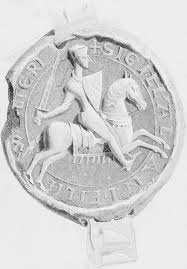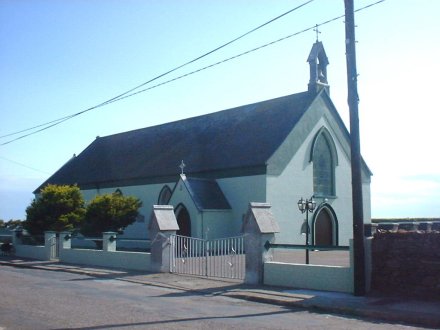
A medieval charter with seals attached. One seal is for the granter, the others are for the witnesses. This is NOT one of the charters mentioned in this post.
When the Anglo-Norman invaders Milo de Cogan and Robert FitzStephen invaded the kingdom of Cork in 1177, they immediately began to donate some of the income from their land seizures to a small Benedictine priory in Exeter, in the county of Devon.
The Priory of St Nicholas was founded following after William the Conqueror presented the church of St Olave in Exeter to his newly founded Battle Abbey in Sussex. Battle Abbey was founded by William after 1070 on the site of the Battle of Hastings after he was instructed to do so by Pope Alexander II in reparation for the volume of blood spilled during the battle in 1066.
Two years after the battle of Hastings, William laid siege to Exeter, which had rebelled against him. The rebellion had probably been instigated by the lady Githa, the mother of King Harald Godwinson, the Anglo-Saxon king killed at Hastings. William took a fearful revenge on Exeter, but Githa managed to escape into exile, probably in her birthplace of Denmark. Shortly after his foundation of Battle Abbey, in 1070, William gave the Exeter church of St Olave to the abbey. The abbey sent a party of monks to Exeter to administer the church and its estates. They promptly set about building a monastery and a new church for the monastery, which they dedicated to St Nicholas in 1087, the very year that William the Conqueror died. The priory remained relatively small and subordinate to Battle Abbey until the smaller monasteries were dissolved by King Henry VIII in 1536. The prior and monks were pensioned off and the church and cloister pulled down. The remaining structures were sold off and later transformed into a large house during the reign of Queen Elizabeth I.
From 1177, the priory was the beneficiary of grants made to it by the Anglo-Norman invaders of Ireland. Some of these endowments were in County Wexford, but it seems the majority were in County Cork. The church of St Sepulchre on the south side of the city was renamed for St Nicholas when it was given to the Exeter priory by Milo de Cogan, with a considerable parcel of land outside the city. The old Church of Ireland of St Nicholas on Douglas Street is on the same site.
In 1936, the Royal Irish Academy published the records of these grants in an article written by Dr Eric St John Brooks (Litt D), who had inspected them in the Exeter Muniment Room. The Bedfordshire Historical Record Society informs us that Dr Eric St John Brooks (1883-1955) was born in Dublin but spent most of his career in England working for The Times and the Times Literary Supplement. His research interests focused on Irish history and he became one of the leading authorities on the Anglo-Norman period and edited documents for the Irish Manuscripts Commission.
The documents that Dr Brooks recorded consist of ten charters of which two refer to County Wexford and the rest are concerned with County Cork. Four of these are joint grants of Robett FitzStephen and Milo de Cogan, One is from Milo de Cogan, another is from his brother, Richard de Cogan, a most interesting one referring to Imokilly comes from Thomas de Landri (locally Landers), and a final one comes from Bishop Alan O’Sullivan of Cloyne and refers to lands in Imokilly. The seal of Robert FitzStephen is also preserved on some charters, depicting a knight on horseback. Milo de Cogan and his brother also have seals depicting a tree.

The seal of Alan FitzWalter resembles that of Robert FitzStephen. The knight on horseback was a popular motif for seals of landowners in the 12th century.
The reference to the deeds will also include supplementary information derived from Paul McCotter’s important work: A History of the Medieval Diocese of Cloyne (2013), a work that seriously updates Brooks’ paper.
The seven earliest deeds relating to County Cork are written in the what seems to be the same hand, except for that of Thomas de Landri. There is also a cartulary or roll of charters, all copied from originals around the time of King Edward I (reigned 1273-1307). Sadly, the edges of the vellum cartulary had been nibbled by generations of mice by the time Brooks recorded the documents it contained. This meant that some of the details of the documents have been destroyed. But reference to other evidence suggested solutions to some of the missing details.
This post will deal with the documents relating to Imokilly and Barrymore.
Document 1: This was a grant by Thomas de Landry of all the tithes of Balicornere to St Nicholas Priory in Exeter. This was a grant of all the tithes of the parish of Ballygourney, also called Ballintemple or Churchtown South in Imokilly. the grant doesn’t mention a church in Ballygourney, so it seems that there was no church there at the time. Indeed the parish may only have been formed, perhaps with this grant. We know from later sources that the parish church was later dedicated to St Nicholas suggesting that the priory in Exeter had the medieval church constructed and dedicated to its own patron saint. Thomas de Landri’s descendants gave their name to the townland of Ballylanders in this parish. This deed can be dated some time between 1177 and 1182.
Document 2: A deed granted by Bishop Alan (O’Sullivan) of Cloyne (1240-1248) to St Nicholas of Exeter of the lands of ‘Killmedwa’ and ‘Ardcatten.’ These two places are not precisely identified. It is thought that ‘Killmedwa’ was actually Kilva townland, located north of Cloyne. The priory had to pay a rent of 2 pounds of wax annually on the feast of St Colman (24th November). The grant also included a messuage (a town holding) at ‘Imelbeltim’ in Cloyne. One of the witnesses was Thomas de Cavilla, who was later confirmed as prebend of Kilcredan in 1248. This deed was dated 7th March 1244 and granted at Cloyne.
Turning to the cartulary roll we have a number of other documents to consider below.
Document 3: Grant of Robert FitzStephen of the lands of ‘Chelmechwe’ and ‘Canetocher’ and ‘Artathy’ to St Nicholas of Exeter for the soul of the granter’s brother, William Wallensis (Walsh), and for the soul of the granter’s soul, of his wife’s soul, his father’s soul and that of his mother. The lands named above are identified by Brooks as Kilva (‘Chelmechwe’ – also ‘Killmedwa’ above?). ‘Canetocher’ is probably Carrigatogher townland. ‘Artathy’ is uncertain but it must have been high ground in the vicinity of the first two, on the high ground north of Cloyne.William Wallensis or ‘Walsh’ as we would now call him was originally William of Hay, who with his brothers, Walter and Howel, were all sons of the famous Nesta of Wales – who was also the mother of Robert FitzStephen. McCotter disagrees with Brooks, who thought it was near Castlemartyr, and suggests that it refered to Aghada parish.
Document 4: Grant of Roger de Caunttiton (Condon) of his church of Corkbeg to St Nicholas of Exeter. the grant also includes ‘Incheogaryanochillan’. This last is probably not the parish of Inch but may refer to the island of Corkbeg.
Document 5: Grant of Robert FitzStephen to St Nicholas of Exeter of ten carucates of land between a ‘dún and the sea’ and another ten carucates ‘beyond the wood.’ This was almost certainly in the parish of Aghada where the dun was probably the site of FitzStephen’s first castle in Imokilly. Brooks suggests that it was in the land between Ballinacurra and Castlemartyr, but McCotter is surely correct to identify it as the parish of Aghada. The grant also included the chapel of his castle – so this was the origin of the parish of Aghada, and its appropriation by St Nicholas of Exeter. In theory a carucate was about 120 acres but it varied depending on the fertility of the soil.
Document 6: A grant by Walter FitzRobert of the church of Clonpriest to St Nicholas of Exeter. This included all the tithes and benefits of the church and parish. The proviso was that the granter’s son, William, would hold the church for life, paying the priory of St Nicholas a pound of wax every year. It seems that St Nicholas Priory didn’t hold this property for very long because it ended up in the parish of Youghal and was held by the College of St Mary in Youghal from the 1400s.

Seal of Gilbert de Clare about 1148. Gilbert was Earl of Pembroke and the father of Richard FitzGilbert de Clare – better known as Stongbow.
Document 7: Robert de la Marshall granted his church of ‘Chalcorfyn’ with all tithes, oblations and with 1 knight’s fee to St Nicholas of Exeter. The grant was also quit of all obligations to him. This was the parish of Kilcurfin which was a separate parish until the early 1600s when it was united with Carrigtwohill parish. The townland of Kilcorfin lies north west of the village of Carrigtwohill. This grant was probably made in 1185.
What these documents show is the origin of some of the parishes in East Cork following the arrival of the Anglo-Normans. These parishes were based on the feudal land grants made to his followers by Robert FitzStephen. So these civil parishes approximate to the estates carved out by the invading forces in 1177. The Anglo-Normans (and one Gaelic bishop) settled these properties and incomes on the modest priory of St Nicholas of Exeter immediately after the invasion of 1177. The priory must have been relieved to be so generously endowed so rapidly. It should be noted that in 1615 the FitzGeralds of Ballymaloe claimed that these endowments had belonged to the Abbey of Chore – a breathtaking act of fraud following the Reformation!
